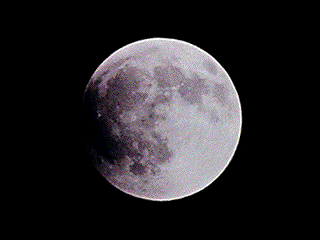

A Total Lunar Eclipse photographed on Aug. 16, 1989 near Hillsdale, Kansas, USA. Series starts at about 8:45pm and runs past 11:00pm, central daylight time.
Photos were taken using a Nikon F3 and a 600mm Nikkor lens at f5.6 on Fuji asa 400 color slide film.
All photos (C)1989/1999 ICSTARS Astronomy by Vic Winter.
Exposures randed from 250th of a sec. for "white" phase shots to 1 sec. for the longest totality shot. All were unguided on a tripod.
A brief excerpt from the pages of "MrEclipse.com" Fred Espenak.
Photographing an eclipse of the Moon is fun and easy. You don't even have to worry about special filters to protect your eyes or your camera. Unlike eclipses of the Sun, eclipses of the Moon are perfectly safe to watch with the naked eye.
A lunar eclipse occurs whenever the Moon passes directly through Earth's dark shadow. This can only occur during full Moon. Since we have a Full Moon every 29 and 1/2 days, you'd think we would have a lunar eclipse once a month. Unfortunately, the Moon's orbit is tipped 5 degrees with respect to Earth's orbit around the Sun. As a result, a lunar eclipse can only happen when Full Moon occurs as the Moon passes through Earth's orbital plane. This occurs once or twice every year and the resulting eclipse can be seen from the half of the Earth experiencing night.
Watching and photographing an eclipse of the Moon is a relaxing activity since it progresses at a relatively leisurely pace. The eclipse begins as a small notch slowly appears along one edge of the Moon. During the next hour or so, the Moon gradually dips deeper into Earth's dark umbral shadow. If the eclipse is a total one, the last remaining minutes of the partial phases can be quite dramatic and beautiful. The crescent of the Moon grows thinner as darkness propagates through a night sky now deprived of moonlight. If you're away from city lights, the Milky Way becomes bright and beautiful as the total phase begins. It's quite a remarkable sight.
For more on photographing lunar eclipses take a look at one of Fred's Lunar Eclipse pages.
Back to ICSTARS
[Educational Features] [Favorite Links] [Recommended Vendors] [Shopping Page] [Astronomy Photos]